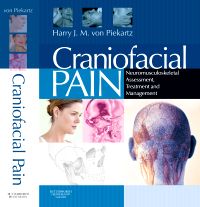Craniofacial Pain, 1st Edition
Neuromusculoskeletal Assessment, Treatment and ManagementKey Features
- Practical, evidence-based and comprehensive
- Highly illustrated
- Clearly described manual techniques and management strategies
- Clinically relevant
- Includes contributions from leaders in the field
- Covers adult and paediatric treatment
Author Information
| ISBN Number | 9780750687744 |
|---|---|
| Main Author | By Harry J. M. von Piekartz, PhD, MSc, PT, MT |
| Copyright Year | 2007 |
| Edition Number | 1 |
| Format | Book |
| Trim | 189w x 246h (7.44" x 9.68") |
| Imprint | Butterworth-Heinemann |
| Page Count | 752 |
| Publication Date | 22 Apr 2007 |
| Stock Status | IN STOCK - This may take up to 5 business days to ship |
"Reading through his thought provoking book, von Piekartz provides new clinical theories including a number of functional cranial nerve tests that are entirely novel. The assessment of the vertebral regions was based on Maitland’s methodology, which is accessible to all manual therapists including osteopaths and chiropractors....It is rare to find an authoritative commentary on a specialist medical topic that provides an opinion on the ongoing politics of healthcare provision and its management...Pickartz has, with the help of his contributors, provided an excellent addition to the accumulating literature on neurological dysfunction and its physical treatment. His book can be thoroughly recommended to all working in the challenging field of physical therapy and the rehabilitation of head pain and dysfunction." Dr Donald Scott
Related Products
-
20% OFF
 Flash Cards
Flash Cards
-
20% OFF
 Book
Nolte's The Human Brain in Photographs and Diagrams
Book
Nolte's The Human Brain in Photographs and DiagramsTodd W. Vanderah
Jan 2019
Special Price $51.19 $63.99 -
20% OFF
 Flash Cards
Flash Cards
-
20% OFF
 Book
Book
-
20% OFF
 Book
Book
-
20% OFF
 Book
Book
-
20% OFF
 Book
Book
-
20% OFF
 Flash Cards
Flash Cards
-
20% OFF
 Online Resource
Netter's Dissection Video Modules (Retail Access Card)
Online Resource
Netter's Dissection Video Modules (Retail Access Card)University of North Carolina Chapel Hill and Frank H. Netter
Oct 2015
Special Price $144.79 $180.99 -
20% OFF
 Book
Book




